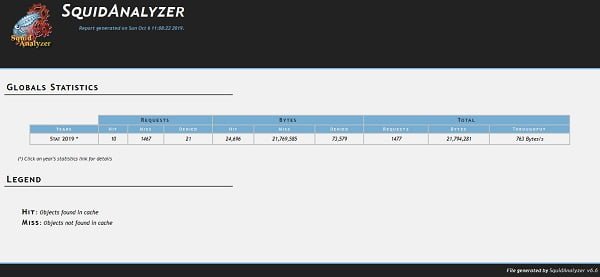Discover how to install SquidAnalyzer on CentOS 7 with our detailed step-by-step guide. Enhance your web traffic analysis with this powerful tool and easy installation process. #centlinux #linux #squidproxy
Table of Contents
What is SquidAnalyzer?
SquidAnalyzer is an open-source tool designed to analyze and report on the logs generated by the Squid proxy server. It provides detailed statistics and visual reports on web traffic, making it easier for administrators to monitor and optimize their network usage. Here are some key features and aspects of SquidAnalyzer:
- Web Traffic Analysis: SquidAnalyzer processes Squid logs to generate comprehensive reports on web traffic. This includes information on visited URLs, bandwidth usage, and the most frequently accessed websites.
- User-Friendly Reports: The tool produces HTML reports that are easy to navigate, with graphs and charts that visually represent the data. This makes it simpler for administrators to understand usage patterns and identify potential issues.
- Detailed Statistics: It provides in-depth statistics on various aspects of web traffic, including user activity, domains accessed, and file types downloaded. This granularity helps in pinpointing specific usage trends and behaviors.
- Customizable: SquidAnalyzer can be customized to fit specific needs, such as setting up filters to exclude certain types of traffic or focusing on particular aspects of the data.
- Lightweight and Efficient: The tool is designed to be lightweight, ensuring it does not add significant overhead to the server. It efficiently processes large log files and generates reports quickly.
- Open Source: Being open source, SquidAnalyzer is freely available and can be modified to suit particular requirements. The community-driven development ensures it stays up-to-date with new features and improvements.
- Integration: SquidAnalyzer can be integrated with other tools and scripts to automate reporting and enhance its functionality within a broader network management system.

Overall, SquidAnalyzer is a valuable tool for network administrators who need to keep track of web traffic and optimize the performance and security of their network.
We install Squid proxy server on CentOS 7 in our previous article. Now, we are installing SquidAnalyzer for Squid log analysis on the same CentOS 7 server to have a analytical view of Squid logs.
SquidAnalyzer Alternatives
If you’re looking for alternatives to SquidAnalyzer for analyzing Squid proxy logs, consider the following options:
- SARG (Squid Analysis Report Generator)
- Generates detailed HTML reports with user activity, sites visited, and bandwidth usage.
- Offers easy integration with web servers like Apache.
- Lightsquid
- A lightweight and simple web-based Squid log analyzer.
- Provides graphical reports and user-based statistics.
- Calamaris
- A flexible Squid log analyzer that generates reports in text, HTML, or CSV formats.
- Suitable for both small and large-scale log analysis.
- AWStats
- Primarily a web analytics tool but can analyze Squid logs.
- Provides graphical reports with detailed traffic statistics.
- GoAccess
- A real-time log analyzer with interactive CLI and web-based reports.
- Supports multiple log formats, including Squid logs.
Each alternative has its strengths depending on your reporting needs, interface preference, and system resources.
Recommended Training: Linux Administration: The Complete Linux Bootcamp in 2025 from Andrei Dumitrescu, Crystal Mind Academy

Linux Server Specification
We have set up and configured a CentOS 7 virtual machine with the following hardware and software specifications to ensure optimal performance and compatibility for our requirements.
- CPU – 3.4 Ghz (1 Core)
- Memory – 1 GB
- Storage – 20 GB
- Operating System – CentOS 7.7
- Hostname – squid-proxy-01.example.com
- IP Address – 192.168.116.214/24
Read Also: How to install CNTLM on Linux
Apple 2025 MacBook Air 13-inch Laptop with M4 chip: Built for Apple Intelligence, 13.6-inch Liquid Retina Display, 16GB Unified Memory, 512GB SSD Storage, 12MP Center Stage Camera, Touch ID; Midnight
$1,049.00 (as of July 5, 2025 20:48 GMT +00:00 – More infoProduct prices and availability are accurate as of the date/time indicated and are subject to change. Any price and availability information displayed on [relevant Amazon Site(s), as applicable] at the time of purchase will apply to the purchase of this product.)Install SquidAnalyzer Prerequisites
SquidAnalyzer is a web-based application designed to generate and display reports in an HTML format. To properly deploy and access these reports through a web browser, a web server is required. In this setup, we will install the Apache HTTP Server, which will serve as the platform for hosting SquidAnalyzer’s web interface.
To proceed with the installation, use the yum package manager to install Apache on your CentOS 7 system. This ensures that SquidAnalyzer’s reports are accessible through a browser over the network.
yum install -y httpdSquidAnalyzer also requires perl compiler for installation.
Install perl packages using yum command.
yum install -y perl perl-develWe are also required git command to clone the SquidAnalyzer source from GitHub.
yum install -y gitInstall SquidAnalyzer on CentOS 7
Download the source code of SquidAnalyzer using git command.
cd /var/www
git clone https://github.com/darold/squidanalyzerOutput:
Cloning into 'squidanalyzer'...
remote: Enumerating objects: 2064, done.
remote: Total 2064 (delta 0), reused 0 (delta 0), pack-reused 2064
Receiving objects: 100% (2064/2064), 1.44 MiB | 640.00 KiB/s, done.
Resolving deltas: 100% (1309/1309), done.
Compile SquidAnalyzer from source code.
cd squidanalyzer/
perl Makefile.PLOutput:
which: no bzcat in (/usr/local/sbin:/usr/local/bin:/usr/sbin:/usr/bin:/root/bin)
Checking if your kit is complete...
Looks good
Writing Makefile for SquidAnalyzer
Done...
Now type 'make && make install'
You can now install SquidAnalyzer on CentOS 7 as follows.
make && make installOutput:
cp SquidAnalyzer.pm blib/lib/SquidAnalyzer.pm
cp squid-analyzer blib/script/squid-analyzer
/usr/bin/perl -MExtUtils::MY -e 'MY->fixin(shift)' -- blib/script/squid-analyzer
Manifying blib/man3/SquidAnalyzer.3pm
Installing /usr/local/share/perl5/SquidAnalyzer.pm
sh install_all.sh
-----------------------------------------------------------------------------
1. Modify your httpd.conf to allow access to HTML output like follow:
Alias /squidreport /var/www/squidanalyzer
<Directory /var/www/squidanalyzer>
Options -Indexes FollowSymLinks MultiViews
AllowOverride None
Order deny,allow
Deny from all
Allow from 127.0.0.1
</Directory>
2. If necessary, give additional host access to SquidAnalyzer in httpd.conf.
Restart and ensure that httpd is running.
3. Browse to http://my.host.dom/squidreport/ to ensure that things are working
properly.
4. Setup a cronjob to run squid-analyzer daily:
# SquidAnalyzer log reporting daily
0 2 * * * /usr/local/bin/squid-analyzer > /dev/null 2>&1
or run it manually. For more information, see /README file.
-----------------------------------------------------------------------------
Appending installation info to /usr/lib64/perl5/perllocal.pod
Edit Apache configuration to add SquidAnalyzer website.
cd
vi /etc/httpd/conf.d/squidanalyzer.confAdd following directives in configuration file.
Alias /squidreport /var/www/squidanalyzer
<Directory /var/www/squidanalyzer>
Options -Indexes +FollowSymLinks +MultiViews
AllowOverride None
Order deny,allow
Deny from all
Allow from 192.168.116.0/24
</Directory>Enable and start httpd.service.
systemctl enable --now httpdConfigure Linux Firewall
Allow HTTP service in CentOS 7 firewall.
firewall-cmd --permanent --add-service=http
firewall-cmd --reloadSet Proxy Server Logfile Location
By default the log file location, provided in squidanalyzer.conf file is incorrect according to our Linux distro. Therefore, we need to correct it before moving forward.
grep LogFile /etc/squidanalyzer/squidanalyzer.confOutput:
LogFile /var/log/squid3/access.log
Update location of log file.
sed -i 's/squid3/squid/' /etc/squidanalyzer/squidanalyzer.conf
grep LogFile /etc/squidanalyzer/squidanalyzer.confOutput:
LogFile /var/log/squid/access.log
Create a Cron Job for SquidAnalyzer
Configure a Cron job for SquidAnalyzer to generate analytical reports.
crontab -eadd following lines therein.
SquidAnalyzer log reporting dailyOutput:
0 2 * * * /usr/local/bin/squid-analyzer > /dev/null 2>&1
We have to explicitly execute squid-analyzer command one time to generate reports in /var/www/squidanalyzer directory.
/usr/local/bin/squid-analyzerAccess SquidAnalyzer Web UI
Open URL http://squid-proxy-01.example.com/squidreport in a web browser.



Configure HTTP Basic Authentication
SquidAnalyzer does not provides a native authentication method.
Since the SquidAnalyzer running as a web application, therefore, we can utilize the HTTP basic authentication to restrict the access to SquidAnalyzer website.
Install httpd-tools using yum command.
yum install -y httpd-toolsOutput:
Loaded plugins: fastestmirror
Loading mirror speeds from cached hostfile
* base: mirrors.ges.net.pk
* extras: mirrors.ges.net.pk
* updates: mirrors.ges.net.pk
Package httpd-tools-2.4.6-90.el7.centos.x86_64 already installed and latest version
Nothing to do
Nothing to do! because, we have already installed httpd-tools during installation of Squid proxy server on CentOS 7.
Create a password file for SquidAnalyzer and add squidadmin user therein.
htpasswd -c /etc/squidanalyzer/passwd squidadminOutput:
New password:
Re-type new password:
Adding password for user squidadmin
Edit Apache configurations to add HTTP basic authentication.
vi /etc/httpd/conf.d/squidanalyzer.confAdd HTTP basic authentication for SquidAnalyzer. Final configuration should be look like this.
Alias /squidreport /var/www/squidanalyzer
<Directory /var/www/squidanalyzer>
Options -Indexes +FollowSymLinks +MultiViews
AllowOverride None
Order deny,allow
Deny from all
Allow from 192.168.116.0/24
AuthType Basic
AuthName "Restricted Content"
AuthUserFile /etc/squidanalyzer/passwd
Require valid-user
</Directory>Test Apache configuration files for syntax errors.
httpd -tOutput:
Syntax OK
Restart Apache service to take changes in effect.
systemctl restart httpd.serviceOpen URL http://squid-proxy-01.example.com/squidreport in a web browser.

Now, it requires user authentication for access to SquidAnalyzer website.
The Ultimate Kali Linux Book: Harness Nmap, Metasploit, Aircrack-ng, and Empire for cutting-edge pentesting
$38.09 (as of July 5, 2025 20:48 GMT +00:00 – More infoProduct prices and availability are accurate as of the date/time indicated and are subject to change. Any price and availability information displayed on [relevant Amazon Site(s), as applicable] at the time of purchase will apply to the purchase of this product.)Frequently Asked Questions (FAQs)
What is SquidAnalyzer?
SquidAnalyzer is a tool that parses Squid proxy logs and generates detailed reports on web usage and traffic statistics.
What are the prerequisites for installing SquidAnalyzer on CentOS 7?
You need Squid, Perl, and essential development tools like GCC and Make to install and run SquidAnalyzer.
Where can I download SquidAnalyzer for CentOS 7?
SquidAnalyzer can be downloaded from its official GitHub repository or installed via package managers if available.
How do I configure SquidAnalyzer after installation?
You need to update the SquidAnalyzer configuration file to specify the Squid log file path and output report directory.
How can I access SquidAnalyzer reports?
Reports are generated in an HTML format and can be accessed through a web server like Apache or directly from the filesystem.
Final Thoughts
Installing SquidAnalyzer on CentOS 7 is a great way to enhance your web traffic analysis capabilities. With detailed insights and easy installation, SquidAnalyzer helps you manage and optimize your network effectively.
Struggling with Linux server management? I offer professional support to ensure your servers are secure, optimized, and always available. Visit my Fiverr profile to learn more!
Optimize your network analysis with expert help. Contact me today!



Leave a Reply
You must be logged in to post a comment.